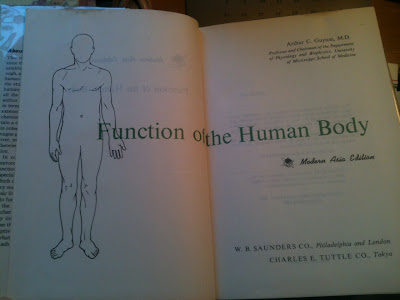Above all else, guard your heart,
for everything you do flows from it.
Proverbs 4:23
Its
unassuming blue canvas cover with gold stamped lettering on the spine sits
humbly on the bookshelf. Few would guess that its content began a revolution
overturning conventional wisdom and launching its record-setting trajectory
that continues today. But peering behind the curtain of time is a back story close
to my heart.
It is early
spring in Oxford in 1955 in the building that still bears his family name.
Dr. Arthur C. Guyton stands in the locking knee brace he invented before his
first year physiology students. W. B. Saunders had approached him about writing
a book, and he needed someone to draw figures, as he called them, to illustrate
his concepts. A classmate raised the arm of another student and urged, “Sonny,
you can draw.”
“See me
after class,” Dr. Guyton said.
These four
words changed my father’s life. They began a journey with pen and ink and daily
brushes with genius.
Dr. Guyton’s
offer provided an artist’s dream: a LeRoy lettering set, a Sears catalog for
ordering supplies, an actual office down
the hall from his for working and studying, and—as though that were not gift
enough—a paying job for four years. Such proximity to a man of Dr. Guyton’s
intellect and generosity of spirit yielded incalculable life lessons.
That new
blue book published in 1956 would be the Textbook
of Medical Physiology, still the definitive text for medical education in
the world.
The first
and second editions contain young Brantley Pace’s original hand-drawn figures
and illustrations in pen and ink and employ the then-high tech zip-a-tone for
others. Graphic design in the 1950s was a skilled hand and an elbow.
Dr. Guyton
said in his original preface, “Many will look upon this one-man attempt to
write a physiology text as extremely presumptuous.” Except that he was the one
man who could do it. Who said, it’s not bragging if it’s true?
Many have
documented his storied tenure at the University of Mississippi Medical School
and his unquestioned genius. UMC writers including Maurine Twiss, Barbara Austin and
Janis Quinn have written of his legacy. Janis Quinn and Carroll Brinson, whose
mother taught me piano in Monticello while I am walking memory lane, authored a
favorite book Arthur C. Guyton which
offers fascinating reading.
Guyton’s
devotion to his wife and family is central to the person he was, and no mention
of his gifted life can omit this aspect. We have family Christmas cards from
the 1960s with black and white photos of the enlarging brood of Guytons still
tucked into the old books with personal notes from Dr. Guyton to my dad. His beloved
Ruthie, as he wrote her name in the dedication of Function of the Human Body, Modern
Asia Edition, another book my father was blessed to illustrate, was an
amazing woman in her own right.
The
University of Mississippi through Guyton began educating medical professionals
around the world in the 1950s and 1960s. My brother was doing orthopedic
surgery in Croatia two decades ago and fetched a copy of Guyton’s text from the
bookshelf there. Few would expect such ripples from this small state.
Fifty-seven
years after its first printing, this masterwork is in its 13th
edition with Dr. John Hall as co-author. Such a publishing feat is
unprecedented.
My daughter had it on her textbook list this fall in a nurse
practitioner program in Nashville and overheard someone question, “University
of Mississippi?...” She could only smile.
When considering what we are to do in this life, I believe our calling is rooted in our giftedness. We often find our calling at the intersection of ability and opportunity. When our talents meet a profound need we have the chance to test drive that calling and see if it is affirmed.
Dr. Brantley
Pace is still practicing medicine 58 years after that fortuitous raised hand initiated a journey with Dr. Guyton he cherishes more each year. And he still pulls out his pen to draw a
figure to illustrate a point or to offer a cartoon bunny rabbit for the
children.
I am
grateful for life’s unexpected blessings that flowed from one man's careful examination of the heart.



Loved this, Marita! Never knew this about your sweet Dad.... So many blessings. You know he was instrumental in helping diagnose Mom's bone cancer... Blessings, indeed.
ReplyDelete